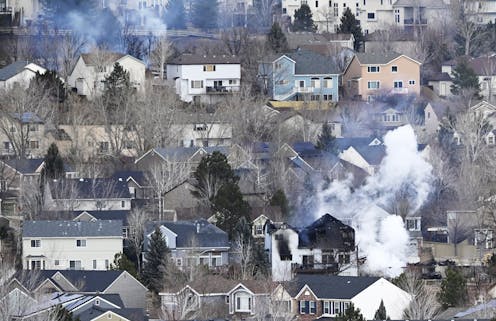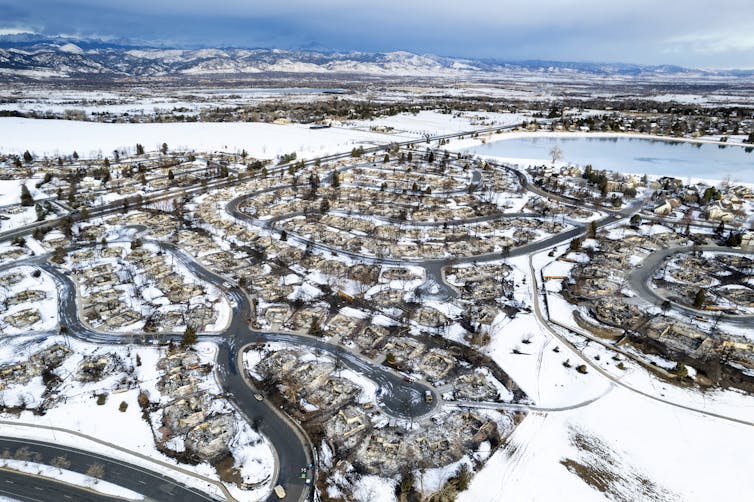3 years after the Marshall Fire: Wildfire smoke’s health risks can linger long-term in homes that es
The fire burned more than 1,000 homes outside Boulder, Colorado, in 2021. A series of surveys shows residents’ continuing health concerns, and tips for how to deal with smoke-damaged homes.

Three years ago, on Dec. 30, 2021, a wind-driven wildfire raced through two communities just outside Boulder, Colorado. In the span of about eight hours, more than 1,000 homes and businesses burned.
The fire left entire blocks in ash, but among them, pockets of houses survived, seemingly untouched. The owners of these homes may have felt relief at first. But fire damage can be deceiving, as many soon discovered.
When wildfires like the Marshall Fire reach the wildland-urban interface, they are burning both vegetation and human-made materials. Vehicles and buildings burn, along with all of the things inside them – electronics, paint, plastics, furniture.
Research shows that when human-made materials like these burn, the chemicals released are different from what is emitted when just vegetation burns. The smoke and ash can blow under doors and around windows in nearby homes, bringing in chemicals that stick to walls and other indoor surfaces and continue off-gassing for weeks to months, particularly in warmer temperatures.

In a new study, my colleagues and I looked at the health effects people experienced when they returned to still-standing homes after the Marshall Fire. We also created a checklist for people to use after urban wildfires in the future to help them protect their health and reduce their risks when they return to smoke-damaged homes.
Tests in homes found elevated metals and VOCs
In the days after the Marshall Fire, residents quickly reached out to nearby scientists who study wildfire smoke and health risks at the University of Colorado Boulder and area labs. People wanted to know what was in the ash and causing the lingering smells inside their homes.
In homes we were able to test, my colleagues found elevated levels of metals and PAHs – polycyclic aromatic hydrocarbons – in the ash. We also found elevated VOCs – volatile organic compounds – in airborne samples. Some VOCs, such as dioxins, benzene, formaldehyde and PAHs, can be toxic to humans. Benzene is a known carcinogen.
People wanted to know whether the chemicals that got into their homes that day could harm their health.
At the time, we could find no information about physical health implications for people who have returned to smoke-damaged homes after a wildfire. To look for patterns, we surveyed residents affected by the fire six months, one year and two years afterward.
Symptoms 6 months after the fire
Even six months after the fire, we found that many people were reporting symptoms that aligned with health risks related to smoke and ash from fires.
More than half (55%) of the people who responded to our survey reported that they were experiencing at least one symptom six months after the blaze that they attributed to the Marshall Fire. The most common symptoms reported were itchy or watery eyes (33%), headache (30%), dry cough (27%), sneezing (26%) and sore throat (23%).
All of these symptoms, as well as having a strange taste in one’s mouth, were associated with people reporting that their home smelled differently when they returned to it one week after the fire.
Many survey respondents said that the smells decreased over time. Most attributed the improvement in smell to the passage of time, cleaning surfaces and air ducts, replacing furnace filters, and removing carpet, textiles and furniture from the home. Despite this, many still had symptoms.
We found that living near a large number of burned structures was associated with these health symptoms. For every 10 additional destroyed buildings within 820 feet (250 meters) of a person’s home, there was a 21% increase in headaches and a 26% increase in having a strange taste in their mouth.
These symptoms align with what could be expected from exposure to the chemicals that we found in the ash and measured in the air inside the few smoke-damaged homes that we were able to study in depth.
Lingering symptoms and questions
There are a still a lot of unanswered questions about the health risks from smoke- and ash-damaged homes.
For example, we don’t yet know what long-term health implications might look like for people living with lingering gases from wildfire smoke and ash in a home.
We found a significant decline in the number of people reporting symptoms one year after the fire. However, 33% percent of the people whose homes were affected still reported at least one symptom that they attributed to the fire. About the same percentage also reported at least one symptom two years after the fire.
We also could not measure the level of VOCs or metals that each person was exposed to. But we do think that reports of a change in the smell of a person’s home one week after the fire demonstrates the likely presence of VOCs in the home. That has health implications for people whose homes are exposed to smoke or ash from a wildfire.
Tips to protect yourself after future wildfires
Wildfires are increasingly burning homes and other structures as more people move into the wildland-urban interface, temperatures rise and fire seasons lengthen.
It can be confusing to know what to do if your home is one that survives a wildfire nearby. To help, my colleagues and I put together a website of steps to take if your home is ever infiltrated by smoke or ash from a wildfire.
Here are a few of those steps:
When you’re ready to clean your home, start by protecting yourself. Wear at least an N95 (or KN95) mask and gloves, goggles and clothing that covers your skin.
Vacuum floors, drapes and furniture. But avoid harsh chemical cleaners because they can react with the chemicals in the ash.
Clean your HVAC filter and ducts to avoid spreading ash further. Portable air cleaners with carbon filters can help remove VOCs.
A recent scientific study documents how cleaning all surfaces within a home can reduce reservoirs of VOCs and lower indoor air concentrations of VOCs.
Given that we don’t know much yet about the health harms of smoke- and ash-damaged homes, it is important to take care in how you clean so you can do the most to protect your health.
Colleen E. Reid receives funding from NSF, NIH, and the U.S. EPA for her research. She has previously received funding for her research from the CDC, the Robert Wood Johnson Foundation, and the JPB Foundation.
Read These Next
Midlife weight gain can start long before menopause – but you can take steps early on to help your b
What you do in the years leading up to menopause can help counter the natural hormonal effects of aging,…
Who thinks Republicans will suffer in the 2026 midterms? Republican members of Congress
The president’s party almost always loses seats in the midterms. More than two dozen Republican House…
New materials, old physics – the science behind how your winter jacket keeps you warm
Winter jackets may seem simple, but sophisticated engineering allows them to keep body heat locked in,…






